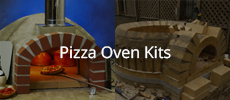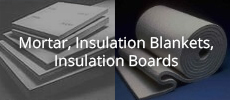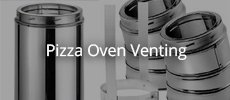The clay flue liner is just sitting in place in these pictures, but it gives an idea of what my plan is and what the transition for the flue looks like. I do have another section of liner, but I’m not sure if I’m going to use it.
Announcement
Collapse
No announcement yet.
40” Pompeii in Rhode Island
Collapse
X
-
For insulation I picked up two boxes of one inch thick ceramic fiber blanket. I set aside enough to wrap the clay flue liner with one layer and put the rest on the dome. This got me three layers over the entire dome and four layers for the lower foot. I picked up a package of rockwool since it is significantly cheaper and won’t actually be touching the dome (although I think that would be fine since it is rated to 2,150F). With the rockwool added most of the dome has 6.5” of insulation on it. Once the enclosure walls are up I will stuff some remaining rockwool in the larger gaps and fill the rest of the void with loose perlite.
I built up a layer of P/V Crete around the base of the oven to support pouring the concrete enclosure walls. I’m going to use hardboard for the form walls. That P/V Crete will hold the bottom of the inner part of the form in place. The P/V Crete is sitting on tile with landscape fabric over it to keep it off the hearth just like under the dome. This introduced a surprising amount of water into the floor and dome. The next day I could see a line in the dome where the water had absorbed to that was about 2 courses up the dome.
I waited a few days for the dome to dry out some and then put a small electric heater in there to help dry it out more. The dome walls are currently sitting at about 160F). I’m at least a week away from having the enclosure walls poured and the clay flue mortared on. I figure I will run the heater until that is done and then start drying fires.
Comment
-
That is going to be quite a insulated beast. I am not sure you will gain much more efficiency with dry perlite and rockwool in over the CaSi and Rockwool but if thats what you want to do have at it. Being in an enclosure will significantly reduce water issues from above and setting the p/vcrete on tile will minimize upward water migration. You can also begin the slow/low cure with charcoal biquettes which will get you around 200F with no flame impingment and you can cook a dutch oven at the same time. Curing is one point where builders get excited, go too fast, too hot and crack the oven. The turtle wins the race in curing.
Comment
-
The package of rockwool was only $50, seemed like a cheap way to make sure I’m well insulated. The problem with the rockwool is that it doesn’t form as well to the shape of the dome. My plan to stuff more rockwool and fill with perlite is more to fill the gaps than add more insulation.
Once the clay flue liner is mortared on and has had a few days to dry I will start drying fires with charcoal briquettes. I already picked up a couple of bags based on your advice in another thread Russell. Thanks for all of the great advice you provide on this forum!
Comment
-
Enclosure walls have been poured. I used some wire mesh to hold 1/2” rebar in place wrapped around the enclosure wall close to the top. Since there will be rafters forming a conical roof, there will be an outward load on the wall at the top. That outward load will pit the concrete in tension, so that is where the rebar is. I also poured the wall thicker on either side of the outer arch to buttress the walls there since there will be the weight of a full masonry chimney sitting the arch. I am thinking about using theroseal on the enclosure walls under the stone veneer to keep water from seeping through.
Comment
-
Coming along nicely, it'll be a beauty when done.
Comment
-
I haven’t had a lot of free time to work on the oven lately, but am still picking away at things little by little. I did a small concrete poor to raise the hearth up to be just below the level of the top of the underfloor insulation. My plan is to poor a small concrete countertop for the oven landing that matches the outdoor kitchen countertop. I will make sure it pitches slightly away from the oven entry so rain water drains away.
I have most of the roof framed out now. I used 20 gauge galvanized steel studs. My plan here is to use durock as the sheathing and put a couple of coats of redguard over that for waterproofing. I’m on the hunt for some used slate shingles, which I will cut into a somewhat pie shape and mortar in place so I don’t put any holes in the roof sheathing. It will be built more like a shower than a typical roof. I do plan on leaving a few air paths at the soffit to let moisture out in case the insulation does get wet.
I also packed a bunch on P/V Crete around the outer arch/flue area. This will isolate the heat in that area from the masonry wrapped around the clay flue liner while still being able to support its weight. Next I’m going to do a small concrete poor that extends the round edge shape of the roof around in front of the outer arch. I got the idea of doing that from the forno bravo vesuvio. Other than liking the look, that will hopefully keep rain out of the oven entry and will provide a place to put an LED under cabinet light to light the entryway at night.
Comment
-
As mentioned in the previous post, I did small concrete poor to extend the round roof shape in front of the oven opening. It needs a little cleanup still, but I’m happy with how that came out. There is a recess in it for an under cabinet LED light.
I wrapped the clay flue liner with ceramic fiber blanket, then added some metal lath and applied the first coat of stucco. I will even it out some with the second coat, but the plan is to cover that with stone veneer eventually. I have been waiting for this step to fire up the oven because I was a little concerned about cracking the flue liner with the inside to outside temperature differential. My goal is to be able to cook the thanksgiving turkey in this oven, so I need to get going with actually using it!
In also installed 1/2” durock for the roof sheathing. It is held down with construction adhesive. Next I will use some thinset and backer tape on all of the joints to really lock it in. Then cover the whole roof in red guard before installing slate shingles.
Comment
-
I got the slates for my oven roof from New England Slate in Vermont. It was worth the trip just to see the operation. We went looking for used slates, but ended up buying new. They have about 10 acres covered with crates of used slates of every size and description.Some of the ones used on cathedral roofs were amazing, about 3x4 ft. It's long enough now that I don't remember why I ended up picking the new ones. They still look great! (you should find pictures in my build thread) Prices were extremely reasonable.
Be advised if you go traditional in your installation the copper nails and flashing will dwarf the price of the slates. I don't know about attaching them to Durock, that wasn't a method I found recommended anywhere; I used fireproof plywood as sheathing, which is not as good for the roof as traditional solid wood laid with gaps. I'd worry that the durock won't hold the nails.
My build thread: https://tinyurl.com/y8bx7hbd
Comment
-
Sorry for the multiple posts. I kept getting a warning saying post failed… apparently it didn’t. I can’t delete them, but if a moderator can that would be appreciated.
rwiegand, thanks for the tip. I think I found a local source for the slate shingles. A buddy put me in touch with a guy that does a lot of high end building work that said he had 5 or 6 different styles of used shingles he had pulled off of housing he was restoring. I’ll report back if that works out.
As for installing the shingles, my plan it is use thinset like they were tiles in a shower. I’m going to coat the durock with red guard, which is a waterproofing membrane. I don’t want to put holes in that like you would with a more traditional installation method. My method would probably be an awful idea with a roof big enough to cover a house, but I think it will work for my application. I guess time will tell.
Comment
-
I've deleted your duplicates...no worries, the forum software has been responding a bit slowly for me as well. I do love the look of your build...it's a stunner!Mike Stansbury - The Traveling Loafer
Roseburg, Oregon
FB Forum: The Dragonfly Den build thread
Available only if you're logged in = FB Photo Albums-Select media tab on profile
Blog: http://thetravelingloafer.blogspot.com/
Comment
-
Thank you SableSprings!
david s, it is insulated with 1” ceramic fiber blanket (see pic in post #68). I was waiting to start the drying fires until I had that done.
I started drying fires yesterday. This was after a week of running an electric heater. I did one stack of charcoal for about 10 hours yesterday. Today I’m running 2 stacks of charcoal. I will start with actual wood tomorrow.
Comment





Comment